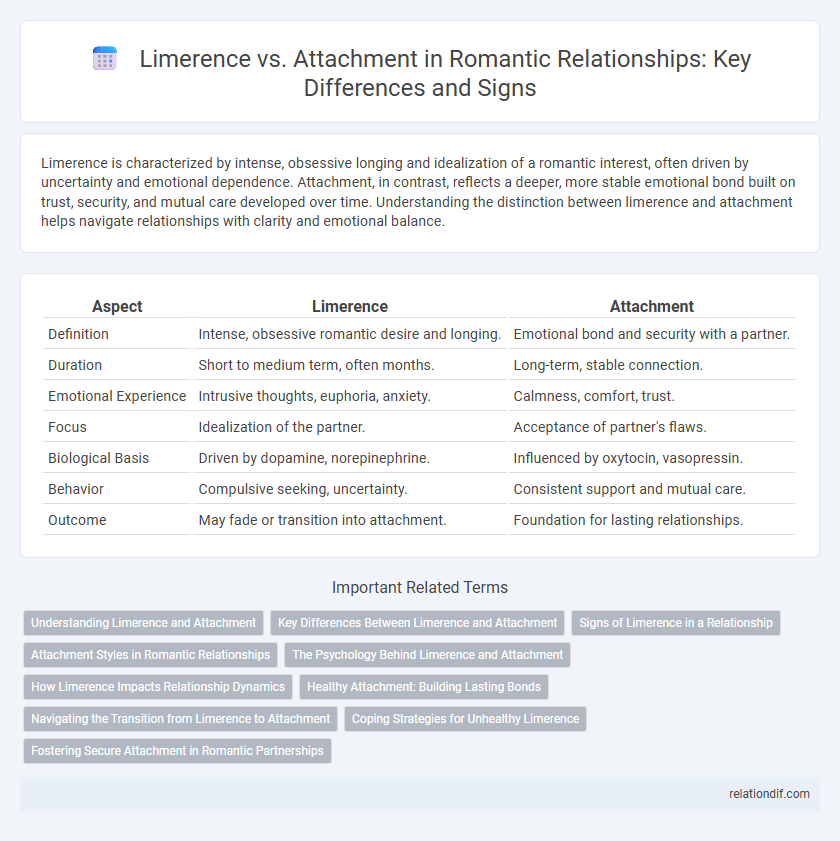Limerence is characterized by intense, obsessive longing and idealization of a romantic interest, often driven by uncertainty and emotional dependence. Attachment, in contrast, reflects a deeper, more stable emotional bond built on trust, security, and mutual care developed over time. Understanding the distinction between limerence and attachment helps navigate relationships with clarity and emotional balance.
Table of Comparison
| Aspect | Limerence | Attachment |
|---|---|---|
| Definition | Intense, obsessive romantic desire and longing. | Emotional bond and security with a partner. |
| Duration | Short to medium term, often months. | Long-term, stable connection. |
| Emotional Experience | Intrusive thoughts, euphoria, anxiety. | Calmness, comfort, trust. |
| Focus | Idealization of the partner. | Acceptance of partner's flaws. |
| Biological Basis | Driven by dopamine, norepinephrine. | Influenced by oxytocin, vasopressin. |
| Behavior | Compulsive seeking, uncertainty. | Consistent support and mutual care. |
| Outcome | May fade or transition into attachment. | Foundation for lasting relationships. |
Understanding Limerence and Attachment
Limerence is characterized by an intense, involuntary emotional longing for reciprocation, often marked by intrusive thoughts and idealization of the beloved. Attachment, in contrast, involves a deeper, more stable emotional bond grounded in trust, security, and mutual care formed over time through consistent interactions. Understanding limerence helps differentiate fleeting infatuation from the enduring connection fostered by attachment in romantic relationships.
Key Differences Between Limerence and Attachment
Limerence involves intense, obsessive longing and idealization of a romantic interest, characterized by intrusive thoughts and acute emotional dependency, whereas attachment reflects a stable, enduring emotional bond rooted in security and mutual support. Limerence often manifests in early stages of infatuation with fluctuating emotions driven by uncertainty, while attachment develops over time through consistent interactions and trust-building. Neurochemically, limerence is associated with elevated dopamine and norepinephrine levels, contrasted with attachment's correlation to oxytocin and vasopressin, which promote long-term bonding.
Signs of Limerence in a Relationship
Signs of limerence in a relationship include obsessive thoughts about the partner, intense longing for reciprocation, and heightened emotional dependence on their responses. Physical symptoms such as a racing heart, nervousness, and euphoria often accompany these psychological patterns, making limerence distinguishable from stable attachment. Unlike attachment, which fosters security and trust, limerence emphasizes uncertainty and idealization, frequently causing emotional turmoil.
Attachment Styles in Romantic Relationships
Attachment styles in romantic relationships significantly influence how individuals experience limerence and attachment. Secure attachment fosters healthy emotional bonds and balanced intimacy, while anxious attachment can heighten limerence characterized by obsessive thoughts and fear of abandonment. Avoidant attachment often leads to emotional distance, minimizing limerence and complicating the development of deep attachment.
The Psychology Behind Limerence and Attachment
Limerence involves an intense, involuntary emotional state characterized by obsessive thoughts and idealization of a romantic interest, driven primarily by dopamine and reward system activation in the brain. In contrast, attachment reflects a deeper, more stable emotional bond rooted in oxytocin and vasopressin, which foster trust, security, and long-term connection between partners. Understanding these psychological mechanisms clarifies how limerence ignites passionate infatuation while attachment sustains enduring love.
How Limerence Impacts Relationship Dynamics
Limerence intensifies emotional investment through obsessive thoughts and idealization, often creating unrealistic expectations within romantic relationships. This heightened state of infatuation can lead to increased dependency, jealousy, and anxiety, disrupting balanced communication and trust between partners. Unlike stable attachment, limerence fluctuates rapidly, making relationship dynamics volatile and challenging to sustain over time.
Healthy Attachment: Building Lasting Bonds
Healthy attachment in romantic relationships fosters emotional security and mutual trust, promoting long-lasting bonds built on empathy and consistent support. Unlike limerence, which is characterized by intense, obsessive infatuation driven by idealization, healthy attachment emphasizes realistic perceptions and acceptance of a partner's strengths and vulnerabilities. Cultivating this secure connection enhances communication, resilience, and intimacy over time, providing a stable foundation for enduring love.
Navigating the Transition from Limerence to Attachment
Navigating the transition from limerence to attachment involves recognizing the shift from intense infatuation driven by idealization to a deeper, more stable emotional bond built on trust and mutual understanding. This process requires emotional regulation and clear communication to foster security while managing the anxious highs of limerent attraction. Emphasizing shared experiences and vulnerability helps establish a resilient attachment that supports long-term romantic connection.
Coping Strategies for Unhealthy Limerence
Unhealthy limerence often manifests as obsessive thoughts and emotional dependence, requiring coping strategies that emphasize self-awareness and emotional regulation. Techniques such as mindfulness meditation, cognitive-behavioral therapy, and establishing personal boundaries help reduce fixation and restore autonomy in romantic relationships. Building a support system alongside professional counseling can facilitate emotional resilience and promote healthier attachment patterns.
Fostering Secure Attachment in Romantic Partnerships
Limerence is characterized by intense, obsessive longing and idealization of a partner, often driven by uncertainty and infatuation, whereas secure attachment in romantic partnerships is built on trust, emotional safety, and consistent responsiveness. Fostering secure attachment involves open communication, empathy, and reliable support, which reduce anxiety and promote a stable emotional connection. Prioritizing these elements leads to deeper intimacy and resilience against relational stressors, distinguishing secure attachment from the fleeting intensity of limerence.
Limerence vs Attachment Infographic

 relationdif.com
relationdif.com